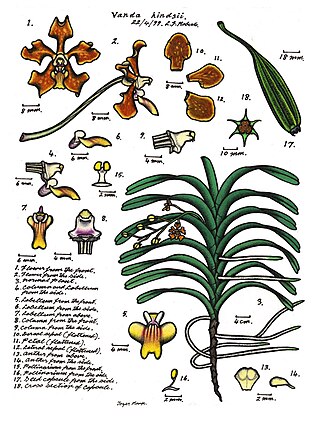Top Qs
Timeline
Chat
Perspective
Vanda hindsii
Species of orchid From Wikipedia, the free encyclopedia
Remove ads
Vanda hindsii, commonly known as the native strap orchid[4] or the Cape York vanda,[1] is a large epiphytic or lithophytic clump-forming orchid. It has thick, white, cord-like roots, branching stems, many thick, leathery, strap-like leaves and between three and seven shiny brown flowers with greenish to yellow markings and a white labellum. This orchid occurs in New Guinea and tropical North Queensland.
Remove ads
Description
Vanda hindsii is an epiphytic or lithophytic herb that forms large, coarse clumps with thick, white, cord-like roots and branching stems up to 1 metre (3.3 ft) long. There are many thick, leathery, glossy, strap-like leaves 200–400 millimetres (7.9–16 in) long and 30–40 millimetres (1.2–1.6 in) wide arranged in two ranks along the stems. Between three and seven brown resupinate flowers with greenish to yellowish markings, 30–35 millimetres (1.2–1.4 in) long and wide are arranged on a stiff flowering stem 100–200 millimetres (3.9–7.9 in) long. The sepals are 14–16 millimetres (0.55–0.63 in) long and 8–10 millimetres (0.31–0.39 in) wide, the petals about the same length but narrower. The labellum is white, 12–14 millimetres (0.47–0.55 in) long and 7–8 millimetres (0.28–0.31 in) wide with three lobes. The side lobes are erect and curved and the middle lobe is about 7 millimetres (0.28 in) long with a notched tip and a spur about 4 millimetres (0.16 in) long. Flowering mainly occurs from November to March.[4][5][6]
Remove ads
Taxonomy and naming
Vanda hindsii was first formally described in 1843 by John Lindley and the description was published in the London Journal of Botany from a specimen collected by Richard Brinsley Hinds.[7][8] The specific epithet (hindsii) honours the collector of the type specimen.[7]
Distribution and habitat
The native strap orchid grows on trees and rocks in humid forests. It only occurs in New Guinea, the Solomon Islands and Queensland where it is found in the Carron Valley, Iron Range and McIlwraith Range.
Conservation status
The global assessment of the conservation status of this orchid in the IUCN Red List of Threatened Species is "least concern",[2] but it is listed as "vulnerable" in Australia under the Australian Government Environment Protection and Biodiversity Conservation Act 1999[1] and the Queensland Government Nature Conservation Act 1992.[9]
References
Wikiwand - on
Seamless Wikipedia browsing. On steroids.
Remove ads



